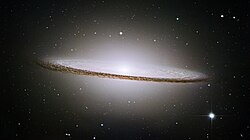Berkas:Sombrero Galaxy in infrared light (Hubble Space Telescope and Spitzer Space Telescope).jpg

Ukuran pratayang ini: 800 × 448 piksel. Resolusi lainnya: 320 × 179 piksel | 640 × 359 piksel | 1.024 × 574 piksel | 1.280 × 717 piksel | 3.000 × 1.681 piksel.
Ukuran asli (3.000 × 1.681 piksel, ukuran berkas: 3,98 MB, tipe MIME: image/jpeg)
Riwayat berkas
Klik pada tanggal/waktu untuk melihat berkas ini pada saat tersebut.
| Tanggal/Waktu | Miniatur | Dimensi | Pengguna | Komentar | |
|---|---|---|---|---|---|
| terkini | 20 Juli 2009 20.46 |  | 3.000 × 1.681 (3,98 MB) | Tryphon | {{Information |Description=NASA/ESA Hubble Space Telescope and NASA's Spitzer Space Telescope joined forces to create this striking composite image of one of the most popular sights in the universe. Messier 104 is commonly known as the Sombrero galaxy bec |
Penggunaan berkas
Halaman berikut menggunakan berkas ini:
Penggunaan berkas global
Wiki lain berikut menggunakan berkas ini:
- Penggunaan pada ast.wikipedia.org
- Penggunaan pada az.wikipedia.org
- Penggunaan pada bs.wikipedia.org
- Penggunaan pada cs.wikipedia.org
- Penggunaan pada de.wikipedia.org
- Penggunaan pada en.wikipedia.org
- Penggunaan pada en.wikiquote.org
- Penggunaan pada en.wikiversity.org
- Penggunaan pada es.wikipedia.org
- Penggunaan pada fa.wikipedia.org
- Penggunaan pada frp.wikipedia.org
- Penggunaan pada fr.wikipedia.org
- Penggunaan pada he.wikipedia.org
- Penggunaan pada it.wikibooks.org
- Penggunaan pada kk.wikipedia.org
- Penggunaan pada kn.wikipedia.org
- Penggunaan pada mg.wikipedia.org
- Penggunaan pada pl.wikipedia.org
- Penggunaan pada pt.wikipedia.org
- Penggunaan pada simple.wikipedia.org
- Penggunaan pada sk.wikipedia.org
Lihat lebih banyak penggunaan global dari berkas ini.


